Blog

FHFA Looks at Impact of LTV on Loan Performance
Sincernthe housing market collapse the focus of policy makers has shifted from puttingrnborrowers into owner occupied housing to keeping them there. In a new paper written by Ken Lam, Robert M.rnDunsky, and Austin Kelly for the Federal Housing Finance Agency (FHFA) financingrnto do so are referred to as “sustainable mortgages.”</p
Onernkey variable for limited default risk at the time a mortgage is originated isrnthe downpayment requirement. While thisrnis not the sole determent of default risk, the authors speculate that the effectrnof changes in the amount of down payment required for a mortgage may berninfluenced by how stringent other underwriting requirements are, particularlyrnthe borrower’s credit score.</p
The FHFA paper, Impacts of Down PaymentrnUnderwriting Standards on Loan Performance – Evidence fromrnthe GSEs and FHA portfolios evaluates the extentrnto which higher down payments produce more sustainable mortgages. The authors used hazard models to estimaternthe relationship between the down payment (the loan to value ratio or LTV)rnrequirements and loan performance, controlling for a wide array of borrower andrnloan characteristics and housing market conditions. </p
The study focuses on the market servedrnby the two government sponsored enterprises (GSEs) Freddie Mac and Fannie Maernand by the Federal Housing Administration (FHA) and was limited to 30-year,rnfixed rate home purchase mortgages. Itrndoes not look at the performance of subprime or Alt-A mortgages. Loans purchased by the GSEs generally requirerna 20 percent down payment, mortgage insurance or a second lien. FHA mortgages may require as little as 3 to 4rnpercent down.</p
Thernstudy used history of loan performance data from the GSEs for loans originatedrnfrom 1995 to 2008 and data from FHA’s single-family data warehouse for loansrnoriginated from 2004 to 2008. Loanrnperformance was observed through December 2012. A 17 percent random sample of loans was drawnrnfrom the FHA loans and a 5 percent random sample from the GSE analysisrnuniverse. The sample represents 2,200,701 FHA loans and 22,138,803 purchasedrnby the GSEs.</p
Loan performance data was merged withrndata from the Bureau of Labor Statistics on state level unemployment rates,rnFederal Reserve information of Treasury yields, and from Freddie Mac onrnprevailing mortgage interest rates. Datarnfor simulating delinquency and foreclosure rates were taken from forecasts ofrnhouse prices, interest rates and unemployment from Moody Analytics.</p
The study used two measures of mortgagernperformance; 90-day delinquency and foreclosure completion which, for GSE loansrnincludes short sales, deeds-in-lieu, third party sales at auction, loans thatrnever entered the bank owned (REO) inventory, and charge-offs in lieu ofrnforeclosure.. For FHA loans foreclosurerncompletion was measured by claim completion. </p
For both the FHArnand GSE market segments a set of explanatory variables was used across the two measures of performance outcomes. The variables included:rn</p<ul class="unIndentedList"<liMortgage age (seasoning).</li<liOrigination year.</li<liFICO score at origination.</li<liLTV ratio at origination.</li<liFront- and back-end debt-to-income (DTI) ratios atrnorigination.</li<liOriginal loan balance.</li<liInteraction of current LTV (on a monthly basis) and FICOrnscore at origination.</li<liSpread between loan's contract interest rate andrnprevailing rate at origination.</li<liInteraction of refinance incentives (spread) and burnoutrnfactor.</li<liYield curve spread.</li<liGeographic variations.</li<liState foreclosure laws. </li<liState unemployment rate.</li<liSource of downpayment funds (FHA only).</li<liPresence of junior liens.</li<liNumber of housing units.</li<liHousing structure type.</li</ul
The authorsrnconducted simulations using regression coefficients and a set of syntheticrnloan-month records with variations across the variables of interest (especiallyrnLTV, FICO score, and frontâ€end DTI), while other loan and borrowerrncharacteristics were held constant throughout. The set of synthetic loanâ€month records were constructed with the following loan and borrower characteristics.</p<ol
This setup generated a total of 12,648 unique syntheticrnloans. For each loan,rnthe authors then generated monthly recordsrnfor seven years following origination. This resultedrnin a total of 1,062,432 loanâ€month records.</p
The outcomes of interestrnare the predicted sevenâ€year cumulative foreclosure completion rate andrnthe predicted sevenâ€year cumulative 90â€day delinquency rate. rnThe focus however was on the former; findings on the 90-day delinquency raternare covered only briefly in this summary.</p
Thernseven-year time span was selected because loan terminations in that timernspan are more likely due to underwriting variables than other triggerrnevents. It becomes increasingly difficult to tease out otherrnconfounding factorsrnin older loans and cumulative rates tend to taper off or flattenrnbeyond 7 years.rnThe measure of delinquency and foreclosurerncompletion used in the study representsrnthe cumulative or lifetimernprobability of a loan becomingrndelinquent (or reaching foreclosure completion).</p
The first finding was that, for both GSErnand FHA segments, as the original LTV increases (with borrower FICO andrnfront-end DTI held constant at 620 and 31 respectively), the lifetimernforeclosure rate rises monotonically. rnFor the GSE loans in the table below, for example, as the original LTV increasesrnfrom 70 to 100, the foreclosure rate climbs progressively from 5.66 percent to 19.77 percent. GSE borrowersrnappear to have a higher foreclosure rate compared to borrowers in the FHA market segmentrnwith the same original LTVrnbut this is an artifact of usingrndifferent foreclosure measures between the two market segments.</p
In the secondrncolumn of each panel foreclosure rate changesrnare presented in ratio format, where the resultsrnare shown relativernto the baseline foreclosure rate for loans with 80 percentrnLTV at loan origination. The Exhibit indicates that, for example,rnthe foreclosure rate is 9.20 percentrnfor a GSE loan with 80 percentrnLTV. If the same loan was underwritten with 90 percent LTV, the foreclosure rate would be 1.48 times the baseline level. rnApparently the LTV†foreclosure rate relationship is nonlinear, especially for the FHA segment.rnWhen the originalrnLTV is changed from 80 to 70, the foreclosure rate would be 0.72 times the baselinernlevel. However, if we adjustrnthe original LTV by the same increment in the otherrndirection – from 80 to 90, the foreclosure rate would be 1.62 times the baseline level. This seems to indicate that foreclosure rates are more sensitive or responsive to LTV changesrnin the FHA than in the GSE segmentrnof the market.</p
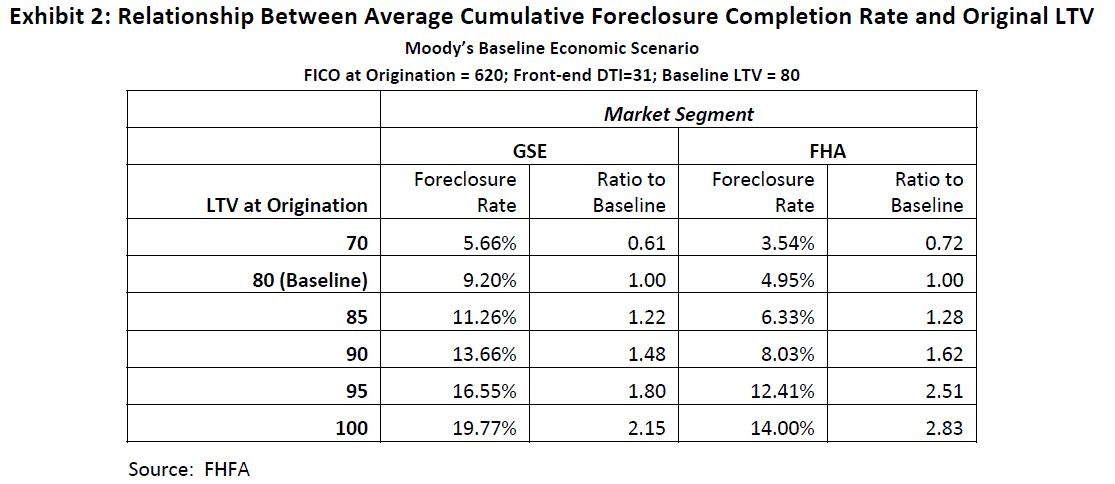 </p
</p
Exhibit 3 repeatsrnthe same analysis, separately, for borrowers with four FICO score levels: 620, 660, 700, and 740rnwith a constant DTI ration of 31 percent. rnBy holding LTV constant, borrowers with a lower FICO score are associated with a higher foreclosure rate. When expressed as a multiplernof the baseline rate, the foreclosure rate grows steadily with LTV in each FICO class. These relationships hold for both GSE and FHArnsegments.</p
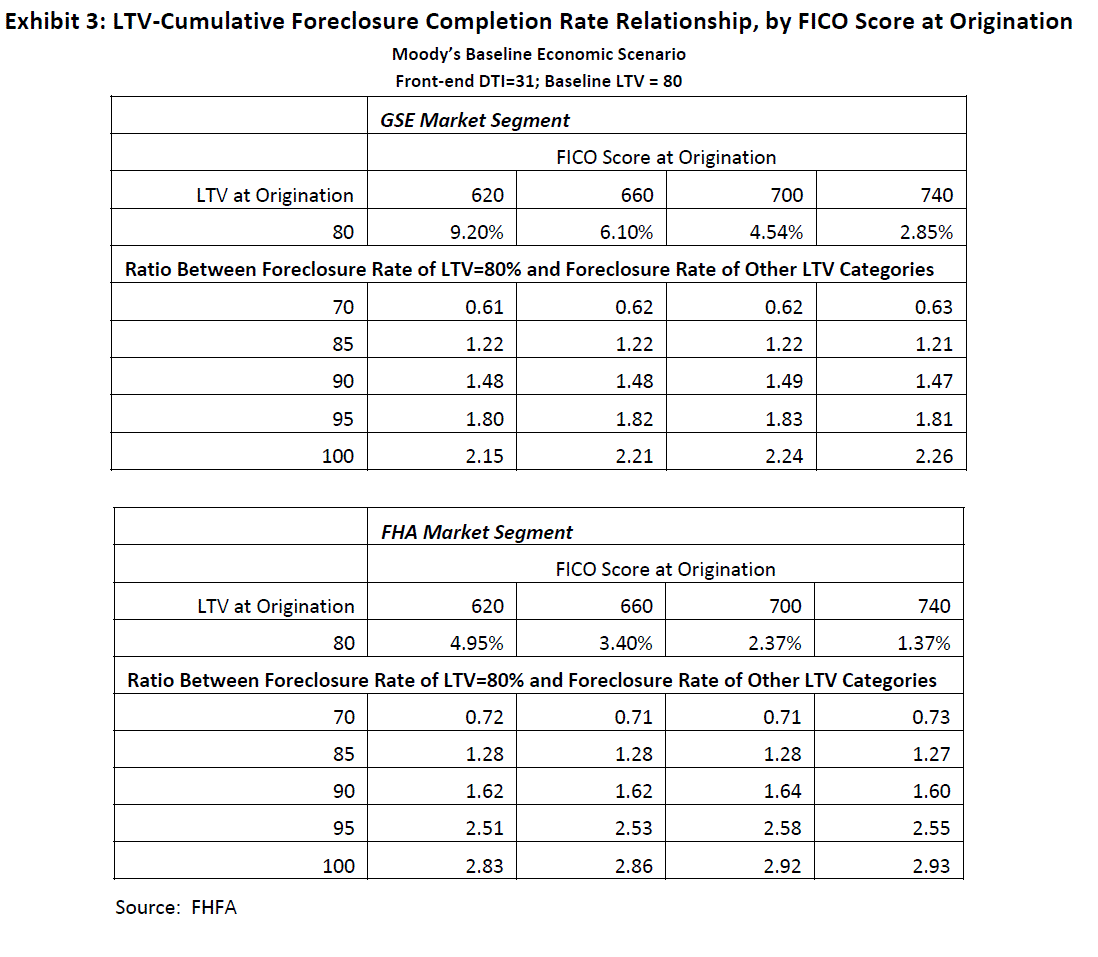 </p
</p
As a multiple of the baselinernrate the rate of foreclosure growsrnsimilarly for the four FICO brackets.rnThis nonetheless does not mean that the growthrnin the foreclosure rate is the same across the four FICO groupings. In fact, the absolute rate of foreclosure rises with LTV much more dramatically for borrowers with lower FICO scoresrnthan for borrowers with a higher FICO.rn</p
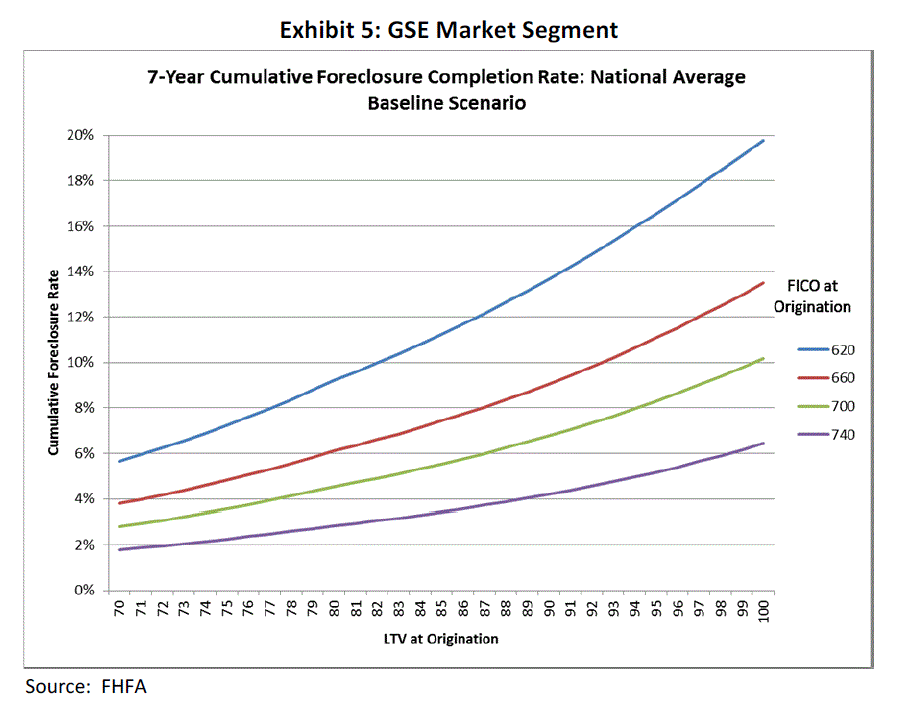 </p
</p
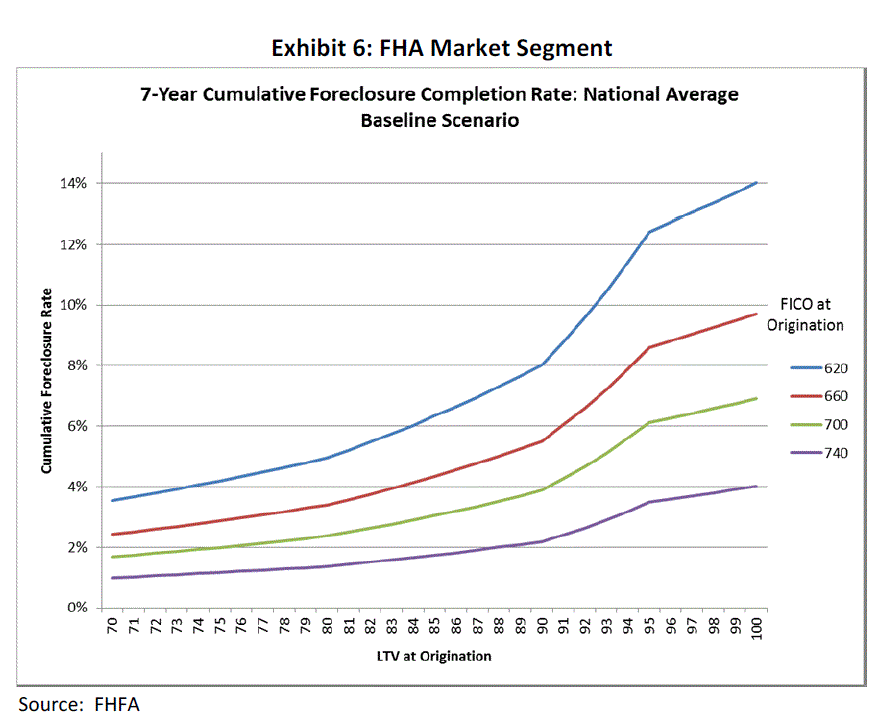 </p
</p
As expected, acrossrnall LTV levels, borrowers with a higher DTI had a higher foreclosure rate. This is true across both marketrnsegments but the LTV-foreclosure rate relationship has a relativelyrnmodest sensitivity to the DTI level. Therndramatic effects of the FICO score impactrnon the LTVâ€foreclosure relationship are not observed here, howeverrnand this is true for both segmentsrnof the mortgage market.rn</p
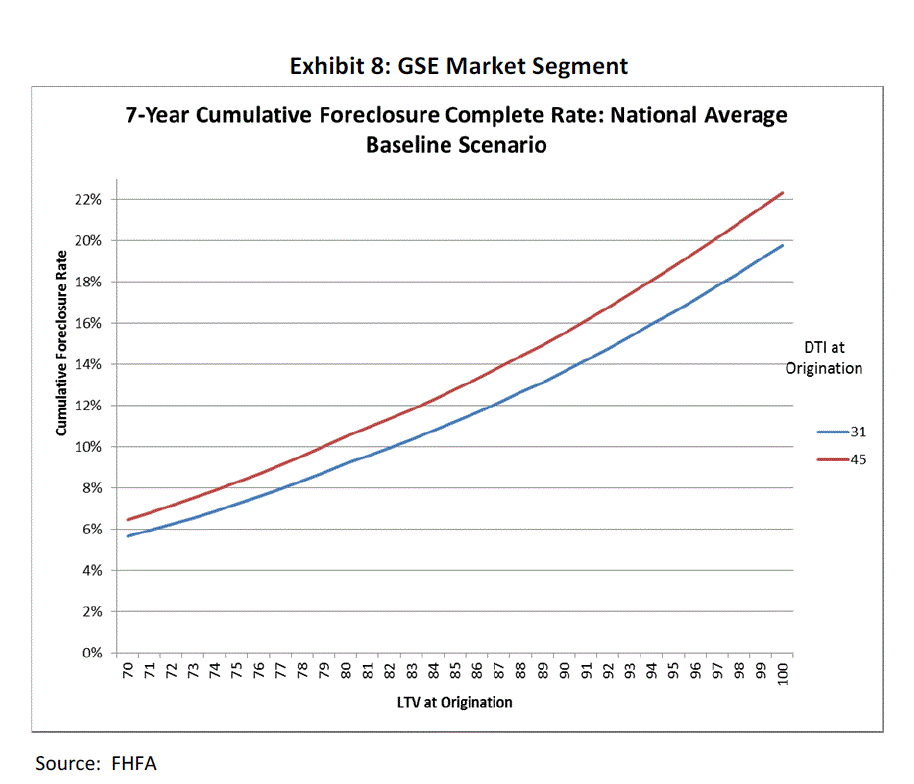 </p
</p
The authors similarly tested relationships with 90 dayrndelinquencies in the same manner as completed foreclosures. Overall, they found that the LTV-delinquencyrnrate relationship is very much like the LTV†foreclosure rate relationship. As the originalrnLTV rises, the lifetimerndelinquency rate increases monotonically. This is true for both segments of the market and across FICO levels. However they found that adjusting thernoriginal LTV generates a larger impact on foreclosure than delinquency for bothrnmarket segments.
All Content Copyright © 2003 – 2009 Brown House Media, Inc. All Rights Reserved.nReproduction in any form without permission of MortgageNewsDaily.com is prohibited.
Latest Articles
By John Gittelsohn August 24, 2020, 4:00 AM PDT Some of the largest real estate investors are walking away from Read More...
Late-Stage Delinquencies are SurgingAug 21 2020, 11:59AM Like the report from Black Knight earlier today, the second quarter National Delinquency Survey from the Read More...
Published by the Federal Reserve Bank of San FranciscoIt was recently published by the Federal Reserve Bank of San Francisco, which is about as official as you can Read More...

Comments
Leave a Comment